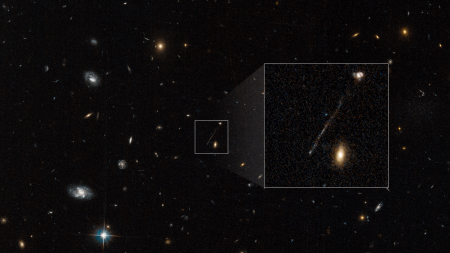- Anything can happen when space stuff bigger than we can conceive smashes together.
Almost every photo has an error in it. Whether it’s due to a scratched lens, light refraction, or poor settings, you can usually find some kind of an artifact or oddity in the picture.
When astronomers noticed a weird white line on an image from the Hubble space telescope, that’s just what they thought it was. An imaging error, probably caused by radiation or something.
They were wrong.
What they’d found was a never-before-seen cosmic phenomenon. A galaxy had spat out a supermassive black hole and sent it hurtling through space.
And that white line? That’s the trail of newly formed stars the black hole is giving birth to in its wake.

‘We Have a Little Streak’
Pieter van Dokkum, a professor of physics and astronomy at Yale University, is the lead author of the study detailing the new discovery. He called finding the black hole “pure serendipity.”
That means a stroke of luck. We’re just saying because we had to look it up.
Van Dokkum wasn’t looking for black holes when he noticed the oddity in the Hubble pictures. He was simply trying to find good old globular star clusters in a nearby dwarf galaxy — as you do.
“I was just scanning through the Hubble image and then I noticed that we have a little streak,” van Dokkum said in a NASA statement.
He didn’t think much of it. Van Dokkum figured it was just a cosmic ray hitting the camera, producing an artifact on the lens.
That kind of thing happens often with space pictures. That’s why NASA has a system to eliminate these kinds of artifacts from telescope photos.
But to van Dokkum’s surprise, that white line was still in the picture even after removing cosmic rays.
“It didn’t look like anything we’ve seen before,” he said.
Now curious, van Dokkum did some follow-up imaging using the W. M. Keck Observatories’ telescope in Hawaii.
“We found that the line and [a nearby] galaxy are connected,” van Dokkum told LiveScience. Further study of the trail produced a reaction straight out of 2001: Space Odyssey.
My god, it’s full of stars!
“We think we’re seeing a wake behind the black hole where the gas cools and is able to form stars. So, we’re looking at star formation trailing the black hole,” explained van Dokkum.
Based on all available evidence, the galaxy the star trail comes from spat out the black hole.
It Takes Three to Space Tango
Deservedly, van Dokkum calls the finding “quite astonishing.” But how does something this unusual happen?
Van Dokkum and his team suspect that the whole thing is a result of a collision between three galaxies and black holes. Initially, the first two black hole-equipped galaxies smashed together, causing the holes to start running circles around each other.
Then, when the third galaxy plummeted into the mix, things got out of hand. Van Dokkum suspects the new black hole essentially booted one of the original due out into space, taking its place in the cosmic dance.
Yet, the new dancers didn’t necessarily escape unscathed. There are features on the other side of the galaxy that suggest the conjoined black holes may have taken off in the opposite direction.
But back to the lone wanderer. Unlike what you might think, it’s not actually destroying planets and stars ahead of him.
Instead, it’s hurtling through a fortunately empty region of space where there’s nothing but gas. The immense gravity of the black hole is condensing the gas into new stars that it leaves behind as it passes.
And it’s passing fast. The black hole is moving at a speed that would allow it to get from Earth to the Moon in 14 minutes.
As such, it’s left a long line of stars behind it. The starry trail is twice as wide as the Milky Way — you know, our home galaxy.
Implications: Unpleasant
But what does this all mean, in the end? Van Dokkum isn’t quite sure yet, as his team hasn’t yet conclusively proven what we’re actually looking at.
But if their theory is true, this is the first time we’ve ever seen anything like it.
“If confirmed, it would be the first time that we have clear evidence that supermassive black holes can escape from galaxies,” said van Dokkum.
To physicists, astronomers, and other space nerds, that’s exciting news. The discovery would confirm a 50-year-old theory and allow scientists to look for similar phenomena elsewhere.
But what about us average Joes and Joleens? Well, we don’t know about you, but we’re more than a bit terrified.
If galaxies can spit out black holes, that means this is probably not the first time it’s happened. How many ginormous black holes are there, plowing their way through the universe?
And how many of them are aimed directly at us?
Hits: 0












